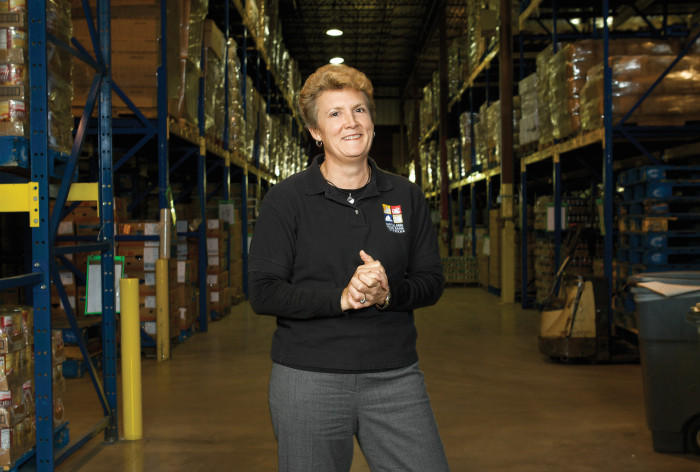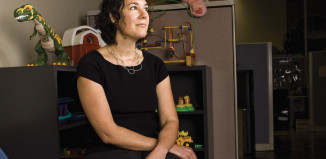Laura Estes ’ voice echoes down the long corridors of the Capital Area Food Bank ’s warehouse, where seemingly endless shelves stacked to the ceiling hold millions of pounds of food.
“This is the nerve center,” Estes says, a grin on her face.
The warehouse is chilly and a faint odor of bananas permeates the air, but Estes is in her element, practically bouncing as she ticks off the logistics and metrics behind the organization.
“People sometimes think of the Capital Area Food Bank as a food pantry, but it’s actually a very complex distribution network,” Estes says.
She would know, perhaps better than almost anyone, what goes in to the nonprofit, which works with more than 350 partner agencies throughout 21 Cen tral Texas counties to get food to those who need it across the region. Estes, who has been a board member with the Capital area food Bank for nine years, just plain loves food.
“I’ve got a real passion about food,” Estes says. “I’ve been in the food business a long time. I like to eat it, I like to grow it, I like to cook it, I like to sell it. But there’s also a big part of me that likes to make sure everyone else in Austin and the surrounding communities gets food. We live in an abundant society, an abundant city, an abundant state and nation, and it just kills me to think that there are people, especially kids, who go to bed hungry. I’ve never been there before, would never want to be there. I want to be part of the solution.”
Estes got involved with the Capital Area Food Bank through H.E. Butt Grocery Co., where she has worked for 25 years, most recently as director of marketing for Central Texas. H-E-B has long been involved in food banking throughout Central Texas, and, as Estes puts it, both organizations have the same goal: getting food to hungry people, whether they can pay for it or not.
As a board member and H-E-B employee, Estes has seen firsthand the changes in demand for food and services, and has had a role in keeping the Capital Area Food Bank at the forefront of the battle against hunger.
Founded in 1981, the Capital Area Food Bank has been in its current south Austin location for 11 years – and is quickly outgrowing that building. When it was built as an expansion of the organization’s former facility, the warehouse was meant to accommodate a capacity of about 15 million pounds of food a year (which has been the average yearly turnover from 2004 to 2008). The food bank so far this year is on par to turn over about 23 million pounds of food. And that need has grown, with new records being broken each month during the past seven months, says Kerri Qunell, vice president of communications for the Capital Area Food Bank . The food bank’s south Austin warehouse, its mothership, is turning the 1.9 million pounds of food on its shelves over completely each month to meet a sharply increased need from its partner agencies. Some of those groups have seen as much as a 300-percent increase in demand from their communities, and Qunell says, overall, there’s been a 60-percent increase in need in the past 12 months from the hundreds of partner agencies the Capital Area Food Bank works with.
To combat that, Estes and others have been trying to think outside the box as much as possible and break free from traditional food banking. In fact, says David Davenport, president and CEO of the Capital Area Food Bank , if the organization hadn’t already transitioned away from traditional food banking, the spike in demand during the past two years of recession would have “eaten us up.”
So the 65 full-time employees and 13,500 unduplicated annual volunteers are working on multiple levels to combat hunger. That’s meant everything from helping those who qualify enroll in snap (the food-stamp program), to bringing a mobile food pantry to rural, underserved areas and urban areas like east Austin where demand and need for food has jumped faster than food pantries and churches can keep up.
To Estes and those she works with at the food bank, hunger is more than the steeply rising numbers, though. Estes recalls a recent 2009 feast of sharing event in Austin that fed holiday meals to more than 10,000 people.
“I was standing in front of the kitchen where meals are served,” Estes says. “A woman walked toward me. … I said, ‘Ma’am, can I help you find something?’ and she said, ‘I just wanted to figure out how to thank all
These people.’ and she put her hand on her stomach, and said, ‘it feels so good to be full.’ What do you say at that point? Most of us are lamenting that we just ate too much … but she had this look of bliss and joy in her eyes.”
The Capital Area Food Bank can do the most with money. (Estes says it can use a $5 donation to buy $25 worth of food, and it gets the bulk of its funding through private donations.) But it also relies on food drives to provide tangible lessons about its services to the community. Estes recalls a food drive that took place after Hurricanes Katrina and Rita when the food bank and H-E-B partnered, hoping to get a few pallets of food. The drive yielded nine trucks full of donated food, and many participants, especially kids, made a visible connection between taking food from their own pantries and sending it to a hungry mouth, she says.
“So, we’ve done some amazing things,” she says. “But what if we have 60 percent more need next year? And what does the community do? This is our issue as Austin: How do we rally folks? Let’s pony up and figure out how to solve this issue together. Because it’s mind-boggling to think about that many million pounds not being distributed, and what the ramifications would be.”
Find out more about Capital Area Food Bank, visit www. Austin foodbank.org.




































